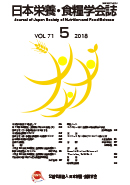
- Issue 6 Pages 267-
- Issue 5 Pages 231-
- Issue 4 Pages 161-
- Issue 3 Pages 117-
- Issue 2 Pages 75-
- Issue 1 Pages 3-
- |<
- <
- 1
- >
- >|
-
(Young Investigator Award of JSNFS (2018))Shigenobu Matsumura2018Volume 71Issue 5 Pages 231-235
Published: 2018
Released on J-STAGE: October 19, 2018
JOURNAL FREE ACCESSDietary fat is an attractive food component. Recent studies have suggested that chemical perception of fatty acid plays a role in the high palatability of fatty foods. Previously, we have found that the fatty acid transporter, CD36, is expressed in rodent taste bud cells, and recently we discovered that G-protein coupled receptor 120 (GPR120) is also expressed in taste cells. GPR120 is known to be a receptor for unsaturated fatty acid, and the mouse is a species known to have a marked preference for unsaturated fatty acids. These findings suggest that GPR120 might function as a sensor for dietary fat. It is well known that intake of palatable food stimulates β-endorphin release in the brain. We have found that dietary fat ingestion activates β-endorphin neurons in the hypothalamus via activation of taste nerves. Taste nerve transection surgery suppressed the activation of β-endorphin neurons resulting from dietary fat ingestion. Taken together, our present findings indicate that dietary fat may stimulate taste cells on the tongue through CD36 and GPR120, thus activating β-endorphin neurons in the brain. It is speculated that activated β-endorphin neurons release β-endorphin to promote consummatory behavior involving fatty foods.
View full abstractDownload PDF (1983K) -
Study on Prevention of Colon Diseases by Functional Foods through Control of the Antioxidant Pathway(Young Investigator Award of JSNFS (2018))Yasuki Higashimura2018Volume 71Issue 5 Pages 237-241
Published: 2018
Released on J-STAGE: October 19, 2018
JOURNAL FREE ACCESSAccumulation of oxidative stress in the colonic mucosa is intrinsically associated with the onset of colorectal cancer and inflammatory bowel disease, suggesting that activation of the anti-oxidation system is important for prevention of these diseases. In the present study, we demonstrated that up-regulation of heme oxygenase-1 expression in macrophages located in the colonic lamina propria was an effective strategy for suppression of intestinal inflammation. We then investigated the therapeutic effect of agaro-oligosaccharides (AGO) , which are products of agarose hydrolysis, using an experimental murine model of colitis. AGO administration was found to markedly attenuate intestinal inflammation in these mice through induction of heme oxygenase-1 expression, and this was associated with significant suppression of neutrophil accumulation and TNF-α spexpression. Furthermore, heme oxygenase-1 induction in macrophages was able to drive a shift in phenotype to anti-inflammatory M2 macrophages. Taken together, the present results suggest that heme oxygenase-1 induction in macrophages located in the colonic lamina propria might be an additional strategy for prevention and treatment of intestinal inflammation.
View full abstractDownload PDF (505K)
-
Hirofumi Koda, Yukako Awaji, Masaaki Uchida, Narumi Nagai2018Volume 71Issue 5 Pages 243-250
Published: 2018
Released on J-STAGE: October 19, 2018
JOURNAL FREE ACCESSThis study was conducted to evaluate sleepiness, changes in body temperature and autonomic nervous system activity after stimulation with the aroma of whiskey. The subjects were 12 young female volunteers. At 9:00 a.m. on two different days, the subjects smelled continuously for 65 minutes a cut cotton pad soaked in whiskey (diluted eight-fold) or water (blank) placed inside a mask. Before and after exposure, subjective sensations of sleepiness and awareness, core (eardrum) and peripheral (toe tip) temperatures, and autonomic nerve activity (heart rate variability) were continuously measured. The findings revealed that: 1) the absolute sleepiness score did not differ significantly between the groups, and 2) the core body temperature increased gradually by approximately 0.05℃ over 65 min in the water group; the core body temperature was increased by approximately 0.15℃ at 30 min, then decreased in the whiskey group. 3) Only in the whiskey group, the difference in core body temperature between the peak value and at each time point (30 and 45 min) was significantly correlated with the change in the sleepiness score. These results suggest that stimulation with the aroma of whiskey may affect the core body temperature. To evaluate the effect of whiskey aroma on sleepiness, further study is warranted.
View full abstractDownload PDF (810K)
-
Ayami Hisanaga, Minoru Sugiura2018Volume 71Issue 5 Pages 251-256
Published: 2018
Released on J-STAGE: October 19, 2018
JOURNAL FREE ACCESSRecently, the Consumer Affairs Agency revised the food labeling system used in Japan. The new system allows fresh agricultural products to be labeled as “Foods with nutrient function claims”. The satsuma mandarin (Citrus unshiu Marcow.) is one of the most commonly consumed domestic fruits in Japan, and is rich in vitamin C. Therefore, there has been high expectation that the satsuma mandarin can be labeled as a food with nutrient function claims. However, there are very few data concerning the differences in ascorbic acid content among cultivars and their associations with fruit quality. In this study, we measured the ascorbic acid content of various satsuma mandarin cultivars in relation to their sugar content. We found that the cultivar with the highest total ascorbic acid content was wase (an early-ripening variety) , followed by gokuwase (an extremely early ripening variety) . On the other hand, okute (a late ripening variety) and a storage cultivar (3 months of storage) had significantly lower total ascorbic acid contents than wase and/or gokuwase, and the oxidized ascorbic acid content was higher in okute and the storage cultivar than in the wase cultivar. The satsuma mandarin cultivar with the lowest oxidized ascorbic acid content was one grown in greenhouses. Our study revealed that ascorbic acid content is significantly and positively associated with sugar content.
View full abstractDownload PDF (441K)
- |<
- <
- 1
- >
- >|